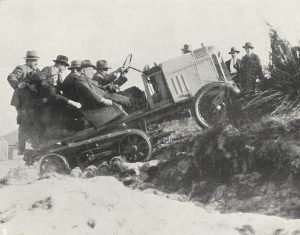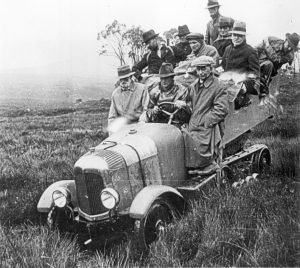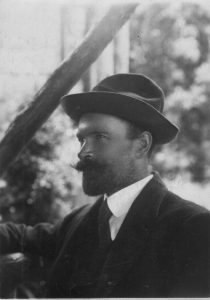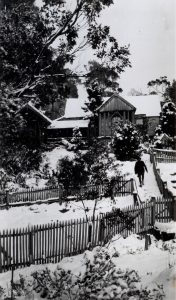
Up one side … a Citröen-Kegresse on the Kensington Sandhills near Sydney. From the Weekly Courier, 27 September 1923, p.23.

Down the other …. the Citröen-Kegresse prototype on its way to Waldheim, 1924. Stephen Spurling III photo courtesy of Anton Lade.
They don’t make Citröens like that anymore. Gustav Weindorfer of Waldheim Chalet, the highland resort at Cradle Valley, beat the snow by shooting for meat on skis when he began living there in isolation in 1912.[1] At around the same time, Tsar Nicholas II of Russia understandably ordered a grander hunting vehicle for snow conditions—with caterpillar tracks for back wheels. Hannibal’s elephantine passage through the Alps to surprise the Romans had nothing on the Citröen-Kegresse, the assault vehicle which resulted from the meeting of French car manufacturer André Citröen and the Tsar’s resourceful mechanic, Adolph Kegresse, after the Russian Revolution.[2]
The Tsar’s caterpillar-tracked hunting technology now drove a prototype that breached the Himalayas en route to China and crossed the Sahara to Timbuktu. It also took a crack at Cradle. In 1924 Latrobe garage owner William Lade publicised his acquisition of a Citröen-Kegresse in Wynyard, Penguin, Latrobe and Devonport, being fined in the last town for demonstrating its ability to climb the steps of the Seaview Hotel.[3] There were fewer rules and few police in the highlands. Rearing over hills and plummeting down the other side, Lade’s vehicle roared up to Waldhiem with ten people aboard close to midnight on 12 April 1924.[4] Launceston’s Daily Telegraph newspaper had high expectations of the Citröen-Kegresse trip:
‘It had been expected that the machine would attempt the last 1½ miles [from Waldheim] to the [Cradle Mountain] summit, but as the rain continued to fall throughout the whole of Sunday the attempt had to be abandoned’.[5]

‘An obstacle surmounter on its hind legs’. The prototype on the inaugural Cradle trip. Don’t forget to pack a newspaper. Stephen Spurling III photo courtesy of the St Helens History Room.
The effect of this visitor on Weindorfer, who may have imagined himself awakened from years of isolation from tourists and supplies, can also be imagined. In preparation for the following summer’s business, Lade then built a shed to house the Kegresse at Moina, about three-quarters of the way to Cradle Valley, the idea being to use conventional transport to bring passengers from the coast that far, swapping to the Kegresse only for the challenging final section. The prospects for tourism seemed rosy. At the time, Weindorfer’s friend Ronald Smith was building a family shack on his own land at the edge of Cradle Valley. ‘Have you finished your place?’, Weindorfer, who called the Kegresse the ‘platypus motor’, asked Smith in October 1924. ‘There might be some business for you’.[6]
The ‘platypus motor’ made four further trips to Cradle in the period January–March 1925. However, tank technology did not take root on the slopes of Cradle Valley or on the road to Cradle. Snowfalls were too inconsistent to attract skiers, and the Citröen-Kegresse disappeared from service after only one further trip, in December 1927.[7] Weindorfer stuck to his skis and joined the Indian corps instead. In 1931 he acquired an Indian Scout motorcycle, meaning that, for the first time, he could motor to and from Cradle Valley at will.
At least, that was the theory. Weindorfer was found dead next to his Indian half a kilometre from Waldheim in May 1932. It appeared that he had suffered a heart attack while trying to kick start the machine.[8] Cradle’s isolation had finally silenced him.
[1] Gustav Weindorfer diary, 17 July 1914, NS234/27/1/4 (Tasmanian Archive and Heritage Office [hereafter TAHO]).
[2] See, for example, John Reynolds, André Citröen: the man and the motor cars, Alan Sutton, 1996.
[3] ‘Motor demonstrations’, Advocate, 9 April 1924, p.2.
[4] Gustav Weindorfer diary, 12 April 1924 (Queen Victoria Museum and Art Gallery [hereafter QVMAG]).
[5] ‘To Cradle Mountain by tractor’, Daily Telegraph, 19 April 1924, p.16.
[6] Gustav Weindorfer to Ronald Smith, 2 October 1924, p.141, LMSS150/1/1 (LINC Tasmania, Launceston).
[7] Gustav Weindorfer diary, 13 December 1927 (QVMAG).
[8] See Esrom Connell to Percy Mulligan, 20 September 1963, NS234/19/1/22; and the coronial enquiry into Weindorfer’s death, AE313/1/1 (TAHO).



This has been very informative, thank you.
Steve, thanks for writing, glad you enjoyed it.
This is a great story to send my Father. He was a mechanic, and loves to hear of the old machines in their heyday ?
Thanks, Alison, I’m glad you enjoyed it.